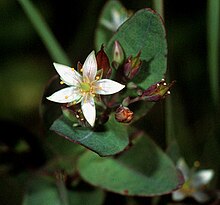| Triadenum | |
|---|---|

| |
| Triadenum virginicum | |
|
Scientific classification
| |
| Kingdom: | Plantae |
| Clade: | Tracheophytes |
| Clade: | Angiosperms |
| Clade: | Eudicots |
| Clade: | Rosids |
| Order: | Malpighiales |
| Family: | Hypericaceae |
| Tribe: | Cratoxyleae |
| Genus: |
Triadenum Raf. |
| Type species | |
|
T. fraseri (Spach) Gleason
| |
| Synonyms [1] | |
| |
Triadenum, known as marsh St. John's worts, [2] is a small genus of flowering plants in the family Hypericaceae. The genus is characterized by opposite, blunt-tipped leaves and pink flowers with 9 stamens. They are distributed in North America and eastern Asia.
Acceptance of this genus is varied. Kew's Plants of the World Online [3] and the Database of Vascular Plants of Canada (VASCAN) [4] treat it as a junior synonym of Hypericum and the Flora of North America [1] and Flora of China [5] treat it as separate. The situation arises from B. R. Ruhfel et al. (2011)'s genetic study describing Triadenum as subsumed under Hypericum and later genetic results disagreeing with this assessment. [6] Under Hypericum, the species are mostly treated as the section Hypericum sect. Elodea. [7]
Species
Triadenum contains the following 6 species according to Flora of North America and Flora of China: [1] [5]
- Triadenum breviflorum (Wall.)
- Triadenum fraseri (Spach) Gleason
- Triadenum japonicum (Thunb.)
- Triadenum tubulosum (Walter) Gleason
- Triadenum virginicum (L.) Raf.
- Triadenum walteri (J.F.Gmel.) Gleason
References
- ^ a b c "Triadenum in Flora of North America @ efloras.org". www.efloras.org. Retrieved 2021-12-15.
- ^ USDA, NRCS (n.d.). "Triadenum". The PLANTS Database (plants.usda.gov). Greensboro, North Carolina: National Plant Data Team. Retrieved 14 December 2015.
- ^ "Triadenum Raf". Plants of the World Online.
- ^ "Triadenum". VASCAN. Retrieved 17 June 2022.
- ^ a b "Triadenum in Flora of China @ efloras.org". www.efloras.org.
- ^ Robson, N. K. (2021). "Studies in the genus Hypericum L.(Hypericaceae) 9. Addenda, corrigenda, keys, lists and general discussion". Phytotaxa. 72: 1–111. doi: 10.11646/phytotaxa.72.1.1.
- ^ Robson, Norman K.B. (11 April 2016). "And then came molecular phylogenetics—Reactions to a monographic study of Hypericum (Hypericaceae)". Phytotaxa. 255 (3): 181. doi: 10.11646/phytotaxa.255.3.1.

